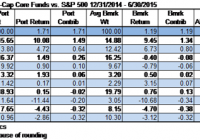Add These Investment-Grade Bond Funds To Your Portfolio
Bonds are assigned ratings based on credit quality. Bond rating firms, like Standard & Poor’s, assign the ratings using upper- and lower-case letters. Usually, “AAA” and “AA” (high credit quality) and “A” and “BBB” (medium credit quality) are the investment-grade bonds. Government bonds, or Treasuries, are not assigned any rating. They generally qualify as the highest credit-quality bonds. A downgrade of a company’s bonds from “BBB” to “BB” reclassifies the debt to “junk” from investment-grade. These can negatively affect bond prices, and the effect of even a one-step drop in quality is problematic for the issuer. Bond funds, however, are a good investment during a low-rate environment. Below, we will share with you 5 buy-ranked Investment-Grade Bond mutual funds. These may be Investment-Grade Bond – Long, Investment-Grade Bond – Intermediate, Investment-Grade Bond – Miscellaneous or Investment-Grade Bond – Short. Each has earned a Zacks Mutual Fund Rank #1 (Strong Buy) or a Zacks Mutual Fund Rank #2 (Buy) , as we expect these mutual funds to outperform their peers in the future. Putnam Absolute Return 700 Fund Inst (MUTF: PDMYX ) seeks to earn 700 basis points, or 7% higher return than U.S. Treasury bills. This higher return of 7% is on an annualized basis, generally over a minimum of 3 years under any market condition. PDMYX combines beta strategy and alpha strategy to seek consistent absolute return. The beta independent investment strategy provides exposure to the investment markets, while the alpha strategy pursues returns from active trading. PDMYX has a 3-year annualized return of 5.3%. The annual expense ratio for Putnam Absolute Return 700 Y is 0.99%, lower than the category average of 1.70%. John Hancock Funds Strategic Income Opportunities Fund C (MUTF: JIPCX ) invests a minimum of 80% of its assets – foreign government and corporate debt securities, U.S. government and agency securities, domestic high-yield bonds, and investment-grade corporate bonds and currency instruments. These may be foreign currency- or US dollar-denominated. JIPCX has a 3-year annualized return of 3.4%. Daniel Janis is the fund manager and has managed JIPCX since 2006. American Funds Intermediate Bond Fund of America Retirement (MUTF: RBOGX ) seeks current income in tune with the quality and maturity standards mentioned in its prospectus. The fund mostly invests in bonds and other debt securities having ratings of A- or better or A3 or better. The bonds, debt securities and money market instruments will have dollar-weighted average effective maturity of at least three years and a maximum of five years. RBOGX has a 3-year annualized return of 1.1%. As of June 2015, RBOGX held 510 issues, with 1.36% of its total assets invested in Canada Govt. 1.5%. Vanguard Intermediate-Term Investment Grade Fund Inv (MUTF: VFICX ) invests a majority of its assets in fixed-income securities of high quality. A large proportion of the securities held are short- and intermediate-term securities rated investment-grade. The average maturity period of the fund ranges from five to ten years. VFICX has a 3-year annualized return of 2.6%. The annual expense ratio for Vanguard Intermediate-Term Investment-Grade is 0.20%, lower than the category average of 0.87% Oppenheimer Core Bond Fund Inst (MUTF: OPBYX ) seeks total return. It invests a large chunk of its assets in investment-grade debt securities. A maximum of 20% of OPBYX’s assets may be invested in junk bonds. Not more than 20% of assets will be invested in foreign debt securities. The fund has a 3-year annualized return of 3.4%. Krishna K. Memani is the fund manager and has managed OPBYX since 2009. Original Post
